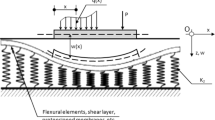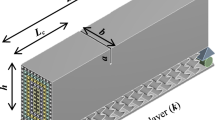Abstract
Functionally graded materials (FGMs) are commonly utilized in construction projects. They enhance the performance of functionally graded beams (FGBs) under various loading conditions. Therefore, the incorporation of variable-section FGBs theory into the analysis of structural and soil interactions is crucial for advancing engineering applications. Employing the variational principle and the transfer-matrix method, and considering the shear stiffness of the axially FGB structure itself, along with the continuity and shear strength of the soil, a semi-analytical solution for displacement and internal force of axially FGBs on Pasternak foundation (termed as P–T model) is derived in this paper. The semi-analytical solution is subsequently compared with finite difference solution results from prior studies, affirming the accuracy and precision of the proposed computational theory. The P–T model degenerates to the Winkler–Timoshenko model (W–T model) when the foundation’s shear layer stiffness is set to zero. Additional analysis is conducted on displacement and internal force variation when the beam stiffness follows different distribution along the axial direction. The results indicate that an asymmetrical distribution of stiffness on either side of the midpoint could increase the displacement at the middle section. Furthermore, when the beam stiffness adheres to a Gaussian distribution along the axial direction of the beam, a significant increase in displacement at the boundary position of the beam is observed. The proposed method is then integrated with the Mindlin stress solution to evaluate construction impact on an existing tunnel within a foundation pit project in Shenzhen. A comparative analysis of theoretical calculations, monitoring data, and numerical simulation results exhibits substantial concurrence across the three methods. The tunnel’s overall deflection adopts an “M” shape, and the computation using the variable-section FGB portrays the existing tunnel’s deformation trend with heightened accuracy, diminishing the calculation error from 35 to 8.3% compared to the conventional normal section beam.














Similar content being viewed by others
References
Y Ma X Du J Wu G Chen F Yang 2020 Natural vibration of a non-uniform beam with multiple transverse cracks J. Braz. Soc. Mech. Sci. Eng. 42 1 12 https://doi.org/10.1007/s40430-020-2246-1
M Song L Chen J Yang W Zhu S Kitipornchai 2019 Thermal buckling and postbuckling of edge-cracked functionally graded multilayer graphene nanocomposite beams on an elastic foundation Int. J. Mech. Sci. https://doi.org/10.1016/j.ijmecsci.2019.105040
AE Alshorbagy MA Eltaher F Mahmoud 2011 Free vibration characteristics of a functionally graded beam by finite element method Appl. Math. Model. 35 1 412 425 https://doi.org/10.1016/j.apm.2010.07.006
M Soltani B Asgarian 2019 New hybrid approach for free vibration and stability analyses of axially functionally graded Euler–Bernoulli beams with variable cross-section resting on uniform Winkler–Pasternak foundation Lat. Am. J. Solids Struct. https://doi.org/10.1590/1679-78254665
K Xie Y Wang X Fan T Fu 2020 Nonlinear free vibration analysis of functionally graded beams by using different shear deformation theories Appl. Math. Model. 77 1860 1880
Y Tang X Lv T Yang 2019 Bi-directional functionally graded beams: asymmetric modes and nonlinear free vibration Compos. Part B Eng. 156 319 331 https://doi.org/10.1016/j.compositesb.2018.08.140
J Fariborz RC Batra 2019 Free vibration of bi-directional functionally graded material circular beams using shear deformation theory employing logarithmic function of radius Compos. Struct. 210 217 230 https://doi.org/10.1016/j.compstruct.2018.11.036
K Xia Y Guiyun 2022 Generalized foundation Timoshenko beam and its calculating methods Arch. Appl. Mech. https://doi.org/10.1016/j.apm.2019.09.024 Prepublish
H Lohar A Mitra S Sahoo 2019 Nonlinear response of axially functionally graded Timoshenko beams on elastic foundation under harmonic excitation Curved Layer. Struct. 6 1 90 104 https://doi.org/10.1515/cls-2019-0008
L Zhang M Zhao C Shi H Zhao 2012 Nonlinear analysis of a geocell mattress on an elastic–plastic foundation Comput. Geotech. 42 204 211 https://doi.org/10.1016/j.compgeo.2012.01.008
L Liang C Xu B Zhu J Deng 2020 Theoretical method for an elastic infinite beam resting on a deformable foundation with a local subsidence Comput. Geotech. https://doi.org/10.1016/j.compgeo.2020.103740
Z Wang C Shi C Gong C Cao Z Peng Y Sun 2022 Difference solutions for responses of foundation-beams with arbitrary boundary conditions considering spatial soil variability and its applications Comput. Geotech. 151 105002https://doi.org/10.1016/J.COMPGEO.2022.105002
Z Li Y Xu D Huang 2021 Analytical solution for vibration of functionally graded beams with variable cross-sections resting on Pasternak elastic foundations Int. J. Mech. Sci. https://doi.org/10.1016/j.ijmecsci.2020.106084
A Shahba S Rajasekaran 2012 Free vibration and stability of tapered Euler–Bernoulli beams made of axially functionally graded materials Appl. Math. Model. 36 7 3094
D Froio E Rizzi 2016 Analytical solution for the elastic bending of beams lying on a variable Winkler support Acta Mech. 227 4 1157 1179 https://doi.org/10.1016/j.ijmecsci.2017.04.021
N Wattanasakulpong V Ungbhakorn 2014 Linear and nonlinear vibration analysis of elastically restrained ends FGM beams with porosities Aerosp. Sci. Technol. 32 1 111
M Song Y Gong J Yang 2020 Nonlinear free vibration of cracked functionally graded graphene platelet-reinforced nanocomposite beams in thermal environments J. Sound Vib. 468 115115
ME Sari M Shaat A Abdelkefi 2017 Frequency and mode veering phenomena of axially functionally graded non-uniform beams with nonlocal residuals Compos. Struct. 163 280 292 https://doi.org/10.1016/j.compstruct.2016.11.093
Y Zhao Y Huang M Guo 2017 A novel approach for free vibration of axially functionally graded beams with non-uniform cross-section based on Chebyshev polynomials theory Compos. Struct. 168 277 284 https://doi.org/10.1016/j.compstruct.2017.02.012
T Yan J Yang S Kitipornchai 2012 Nonlinear dynamic response of an edge-cracked functionally graded Timoshenko beam under parametric excitation Nonlinear Dyn. 67 1 527
N Nešić M Cajić 2022 Nonlinear vibration of a nonlocal functionally graded beam on fractional visco-Pasternak foundation Nonlinear Dyn. 107 3 1
KD Nguyen HQ Nguyen TT Tran 2017 Vibration of bi-dimensional functionally graded Timoshenko beams excited by a moving load Acta Mech. 228 1 141
L Li D Zhang W Zhu 2014 Free vibration analysis of a rotating hub–functionally graded material beam system with the dynamic stiffening effect J. Sound Vib. 333 5 1526
S Dong L Li D Zhang 2019 Vibration analysis of rotating functionally graded tapered beams with hollow circular cross-section Aerosp. Sci. Technol. 95 C 105476
S Sınır M Çevik BG Sınır 2018 Nonlinear free and forced vibration analyses of axially functionally graded Euler–Bernoulli beams with non-uniform cross-section Compos. B Eng. 148 123 131 https://doi.org/10.1016/j.compositesb.2018.04.061
D Cao Y Gao 2019 Free vibration of non-uniform axially functionally graded beams using the asymptotic development method Appl. Math. Mech. 40 1 85 96 https://doi.org/10.1007/s10483-019-2402-9
I Esen 2019 Dynamic response of a functionally graded Timoshenko beam on two-parameter elastic foundations due to a variable velocity moving mass Int. J. Mech. Sci. 153–154 21
Y Huang XF Li 2010 A new approach for free vibration of axially functionally graded beams with non-uniform cross-section J. Sound Vib. 329 11 2291 2303
L Jing P Ming W Zhang 2016 Static and free vibration analysis of functionally graded beams by combination Timoshenko theory and finite volume method Compos. Struct. 138 192
MY Hossein R Saba 2020 Thermal buckling analysis of porous functionally graded nanocomposite beams reinforced by graphene platelets using generalized differential quadrature method Aerosp. Sci. Technol. 107 106261 Prepublish
F Mustapha J Mohammad Z Abdelkabir 2021 Bending analysis of functionally graded graphene oxide powder-reinforced composite beams using a meshfree method Aerosp. Sci. Technol. 110 106479
XF Li 2008 A unified approach for analyzing static and dynamic behaviors of functionally graded Timoshenko and Euler–Bernoulli beams J. Sound Vib. 318 4–5 1210 1229
Z Zhang C Zhang K Jiang Z Wang Y Jiang Q Zhao M Lu 2019 Analytical prediction for tunnel-soil-pile interaction mechanics based on Kerr foundation model KSCE J. Civ. Eng. 23 2756 2771 https://doi.org/10.1007/s12205-019-0791-x
Y Miao Y Shi G Wang Y Zhong 2017 Closed-form solution of beam on Pasternak foundation under inclined dynamic load Acta Mech. Solida Sin. 30 6 596 607 https://doi.org/10.1016/j.camss.2017.10.006
J Liu C Shi M Lei C Cao Y Lin 2020 Improved analytical method for evaluating the responses of a shield tunnel to adjacent excavations and its application Tunn. Undergr. Space Technol. 98 103339https://doi.org/10.1016/j.tust.2020.103339
HN Wu SL Shen J Yang A Zhou 2018 Soil-tunnel interaction modelling for shield tunnels considering shearing dislocation in longitudinal joints Tunn. Undergr. Space Technol. 78 168 177 https://doi.org/10.1016/j.tust.2018.04.009
Z Li Y Xu D Huang Y Zhao 2020 Two-dimensional elasticity solution for free vibration of simple-supported beams with arbitrarily and continuously varying thickness Arch. Appl. Mech. 90 275 289 https://doi.org/10.1007/s00419-019-01608-y
S Kumar 2022 Vibration analysis of Non-uniform axially functionally graded beam resting on Pasternak foundation Mater. Today Proc. 62 619 623 https://doi.org/10.1016/J.MATPR.2022.03.622
DM Zhang ZK Huang ZL Li X Zong DM Zhang 2019 Analytical solution for the response of an existing tunnel to a new tunnel excavation underneath Comput. Geotech. 108 197 211 https://doi.org/10.1016/j.compgeo.2018.12.026
L Wang R Liang Z Li 2022 Study on uplift deformation of existing shield tunnel induced by excavation of foundation pit upper span Appl. Mech. 39 12 130 140
Q Mao S Pietrzko 2010 Free vibration analysis of stepped beams by using Adomian decomposition method Appl. Math. Comput. 217 7 3429 3441 https://doi.org/10.1016/j.amc.2010.09.010
Acknowledgements
The authors gratefully acknowledge the financial support provided by the National Natural Science Foundation of China (Nos. 51878074, 52278395, and 52078061).
Author information
Authors and Affiliations
Contributions
TL helped in conceptualization, methodology, supervision, writing—review and editing, funding acquisition, project administration. XW was involved in conceptualization, methodology, software, validation, formal analysis, writing—review and editing. JX contributed to methodology, validation, data curation. FH helped in conceptualization, methodology, funding acquisition. YS was involved in software, methodology. WF curated the data.
Corresponding author
Ethics declarations
Conflict of interest
The authors declare that they have no known competing financial interests or personal relationships that could have appeared to influence the work reported in this paper.
Additional information
Publisher's Note
Springer Nature remains neutral with regard to jurisdictional claims in published maps and institutional affiliations.
Appendix
Appendix
In Eq. (12), the detailed expression for \(A_{i} (x),B_{i} (x),C_{i} (x),D_{i} (x)\) is as follows:
Rights and permissions
Springer Nature or its licensor (e.g. a society or other partner) holds exclusive rights to this article under a publishing agreement with the author(s) or other rightsholder(s); author self-archiving of the accepted manuscript version of this article is solely governed by the terms of such publishing agreement and applicable law.
About this article
Cite this article
Ling, T., Wu, X., Huang, F. et al. Variable cross sections functionally grad beams on Pasternak foundations: An enhanced interaction theory for construction applications. Arch Appl Mech 94, 1005–1020 (2024). https://doi.org/10.1007/s00419-024-02562-0
Received:
Accepted:
Published:
Issue Date:
DOI: https://doi.org/10.1007/s00419-024-02562-0




